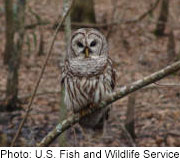
THURSDAY, Jan. 31 (HealthDay News) — What a hoot: Scientists say they’ve discovered how owls can almost fully rotate their heads without damaging the blood vessels in their necks or cutting off the blood supply to their brains.
Owls have four major bone structure and blood vessel adaptations that prevent injury when they rotate their head. Humans lack these adaptations, which helps explain why people are more vulnerable to neck injuries, according to the Johns Hopkins researchers.
“Until now, brain imaging specialists like me who deal with human injuries caused by trauma to arteries in the head and neck have always been puzzled as to why rapid, twisting head movements did not leave thousands of owls lying dead on the forest floor from stroke,” study senior investigator and interventional neuroradiologist Dr. Philippe Gailloud said in a Hopkins news release.
“The carotid and vertebral arteries in the neck of most animals — including owls and humans — are very fragile and highly susceptible to even minor tears of the vessel lining,” added Gailloud, an associate professor in the radiology department at the Johns Hopkins University School of Medicine.
In people, sudden twists of the head and neck can stretch and tear blood vessel linings and lead to blood clots that can break off and cause a stroke. These types of injuries are common and can occur due to whiplash in car crashes, or even after rollercoaster rides or improper chiropractic manipulations, the researchers explained in the news release.
The Hopkins team used angiography, CT imaging scans and medical illustrations to examine the anatomy of a dozen snowy, barred and great horned owls that died of natural causes. Their findings are noted in the Feb.1 issue of the journal Science.
The scientists found that, in owls, bone structure and the vascular network have adapted to support the animal’s top-heavy head. With this anatomical design comes several unusual features.
One of the first things the investigators noticed was the large size of the hollow cavities of the vertebrae in an owl’s neck. This allows extra space for movement of the major arteries that pass through these vertebrae on their way to feed blood and oxygen to the brain. In addition, an owl’s vertebral artery gains even more room and slack by entering the neck at a higher spot than has been seen in other birds.
While studying the owls’ vascular network, the scientists noted a large blood reservoir at the base of the head. This allows the animal to store a blood supply for their brain and eyes while they rotate their head by as much as 270 degrees in either direction. Even if this twisting movement blocks the blood supply along one route, the owls’ interconnected vascular network helps provide uninterrupted blood flow to the brain.
The researchers now plan to study hawk anatomy to see if they possess the same adaptations for head rotation as owls.
More information
The World Owl Trust has more about owls.

